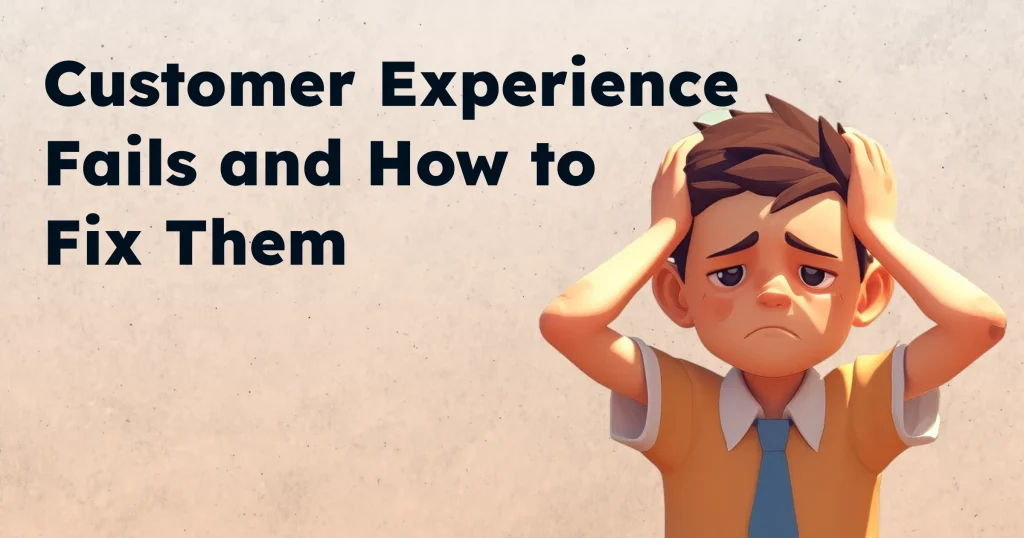In relation to customer experience, many businesses face common pitfalls that hurt their efforts. Understanding common Customer Experience Fails can help businesses avoid these mistakes and improve their services.
You might find that unclear goals, lack of staff training, and ignoring customer feedback are frequent issues.
Furthermore, companies often struggle with flexibility in communication channels and fail to take responsibility for customer service mistakes, which can further damage relationships.
Let’s examine these key takeaways to help you avoid these mistakes and improve your customer interactions.
Customer experience (CX) often fails due to several key reasons:
- Unclear Goals: Lack of clarity in objectives leads to ineffective outcomes.
- Insufficient Staff Training: Poorly trained staff deliver subpar service quality.
- Ignoring Customer Feedback: Neglecting customer input prevents necessary improvements.
- Inadequate Ownership of CX Initiatives: Without clear responsibility, progress is hindered.
- Outdated Technology: Older systems slow response times and frustrate customers.
- Poor Communication: Miscommunication creates confusion and dissatisfaction.
- Inconsistent Service: Lack of consistency drives customers away.
- Lack of Personalization: Customers feel undervalued when their experience isn’t tailored.
- Confusing Websites: Difficult navigation deters potential customers.
- Complicated Payment Process: A frustrating checkout experience drives users away.
- Unclear Billing: Ambiguity in charges erodes trust.
Key Takeaways from Common Customer Experience Fails
In terms of customer experience, you’ll often find some common pitfalls that many businesses face. Understanding these issues, like unclear objectives, inadequate staff training, and neglecting customer feedback, can help you improve your own CX efforts.
Effective workflows can also greatly impact customer service outcomes by streamlining processes and enhancing team communication, contributing to a more satisfactory customer experience improving operational efficiency.
Common issues businesses face with CX
One major issue businesses face with customer experience (CX) is the lack of clear ownership, which often leads to ineffective outcomes and stagnation in CX programs.
This problem can be exacerbated by not understanding customer needs and failing to exceed expectations.
To improve, focus on these areas:
- Break down organizational silos
- Establish clear responsibilities
- Link CX efforts to business goals
- Regularly track CX metrics
These steps can improve customer satisfaction and create a more customer-centric approach.
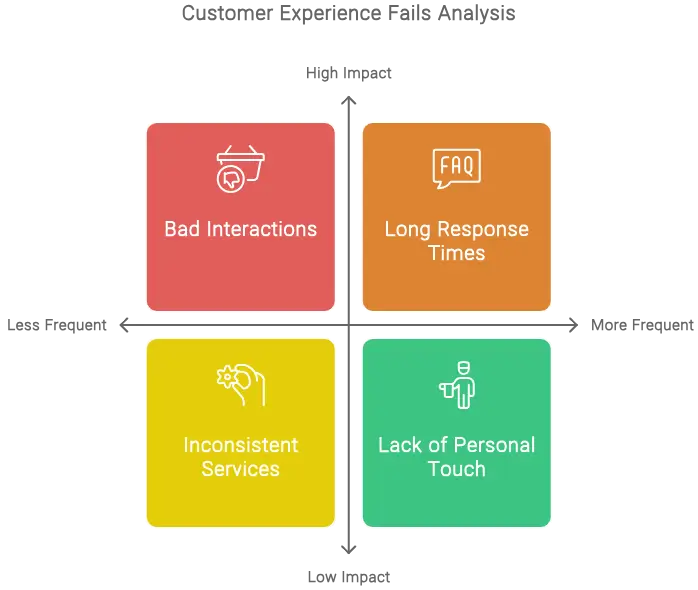
Common Customer Experience Fails
When you think about common customer experience fails, long response times, bad interactions, inconsistent services, lack of personal touch, and insufficient information often come to mind.
These issues can frustrate customers and drive them away, so it’s crucial to recognize and address them. Metrics like First Response Time and Customer Satisfaction (CSAT) scores can provide valuable insights into these areas.
Long Response Times
In the present fast-paced world, long response times can severely hinder customer experience, leaving consumers feeling undervalued and frustrated.
Studies show that 66% of people feel more frustrated waiting on hold than waiting for an email reply. To address this issue, implementing effective customer service channels, such as live chat options, can greatly improve response times.
If your customer service team takes too long to respond, 82% of customers might stop doing business with you. Most customers expect a reply within an hour, and delays can lead to a 20% rise in customer churn.
To enhance customer satisfaction scores, aim to reduce response times to under five minutes. Quick responses not only enhance customer satisfaction but also help maintain loyalty.
Bad Interactions
Bad interactions can derail even the best customer experience strategies, often leaving customers feeling frustrated and undervalued.
Poor customer interactions usually stem from insufficient training for frontline employees, which leads to inconsistent service. When employees lack clear communication skills, misunderstandings arise, creating dissatisfaction.
To combat this, companies should focus on effective customer service techniques that emphasize active listening and empathy. Ignoring customer feedback only worsens these bad interactions, as companies miss chances to address significant issues.
High employee attrition can further harm cx, as new staff may not grasp the company’s customer experience principles. Moreover, overemphasizing automation can strip away the human touch, making customers feel neglected.
To improve, invest in training, encourage open feedback, and find a balance between technology and personal interaction, ensuring customers feel valued and understood.
Inconsistent Services
Consistent service is crucial for maintaining customer loyalty and satisfaction. When you provide inconsistent services, customers can become confused and dissatisfied.
Research shows that 60% of customers prefer brands offering seamless experiences across all touchpoints. Moreover, both customer support and customer success play significant roles in guaranteeing that service consistency is achieved.
If your service quality varies, you risk increasing customer churn by 20%, as customers will look for reliable alternatives. Failing to guarantee uniform service can also harm your brand perception; 80% of customers share negative experiences with others.
On the other hand, organizations that prioritize service consistency can see a 10-15% increase in customer satisfaction scores. To keep customers happy and loyal, focus on providing reliable and consistent service across every interaction.
This approach fosters trust and encourages positive word-of-mouth.
Lack of Personal Touch
A significant lack of personal touch in customer experience can alienate your audience and drive dissatisfaction. When customers feel their individual needs aren’t acknowledged, customer satisfaction plummets, often leading to a 70% increase in dissatisfaction.
Personalization is key; 80% of consumers are more likely to make a purchase when they receive personalized experiences. As noted in numerous studies, understanding customers and their preferences is fundamental for fostering loyalty and engagement, making personalization even more vital in the current competitive market customer-centric companies.
Furthermore, over 60% of customers express frustration if companies don’t recognize their previous interactions. This shows the importance of personalized follow-ups in maintaining customer loyalty.
Additionally, 74% of customers feel frustrated when digital content isn’t tailored to their preferences. By prioritizing a personal touch in your strategies, you can enhance customer loyalty and even see a 10-15% increase in revenue from repeat business and referrals.
Lack of Information
Often, organizations underestimate the importance of having relevant information at their fingertips, which can lead to significant customer experience failures. A lack of information can result in misinformed decisions that fail to meet customer expectations, risking loyalty and satisfaction.
Without effective data analytics, it’s hard to grasp customer needs and preferences, especially as 70% of consumers expect AI to transform their experience with companies. This lack of understanding leads to generic solutions that don’t resonate with your audience.
Furthermore, when organizations don’t regularly collect and analyze customer feedback, they miss critical insights that could inform necessary changes. To improve your customer experience (CX), focus on gathering actionable insights from data and feedback.
Communicate your CX goals clearly, so everyone in the organization can work together effectively and consistently.
Not Using New Technology
Organizations that fail to adopt new technology risk falling behind in the continuously changing landscape of customer experience. By not using AI and automation, you might slow response times and offer less personalized interactions, which can hurt customer satisfaction.
Furthermore, neglecting omnichannel support frustrates customers who expect seamless experiences across platforms, as an omnichannel help desk guarantees consistent interactions across diverse communication channels.
Without effective data analytics, you miss out on understanding customer preferences, leading to generic services that don’t meet specific needs.
Focusing solely on traditional methods limits your innovation and competitiveness in the current market.
To improve your CX programs, accept new technologies, adapt to evolving expectations, and prioritize data-driven strategies, making certain your customers feel valued and understood.
This approach can greatly increase loyalty and reduce churn.
Impact of Bad Customer Experience
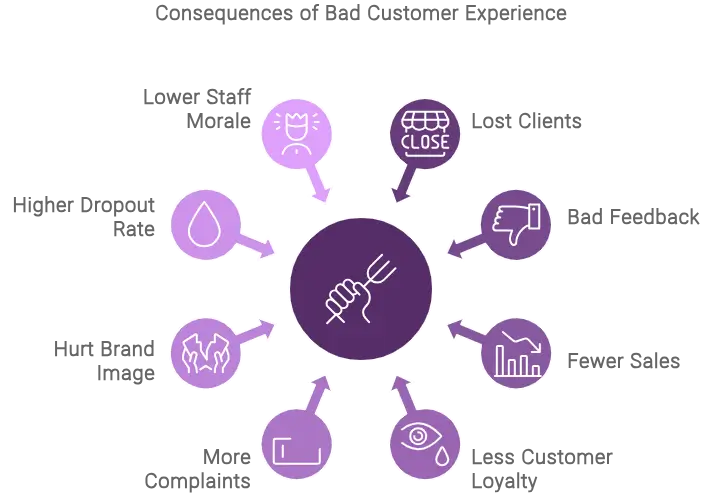
Bad customer experiences can seriously hurt your business.
You risk losing clients, receiving negative feedback, and seeing fewer sales.
Plus, when customers feel dissatisfied, they’re less likely to return, leading to more complaints and less loyalty in general.
Lost Clients
In the quest for customer loyalty, poor experiences can lead to lost clients faster than you might realize. A single negative experience can cause up to 80% of dissatisfied customers to sever ties with your brand.
When customers encounter a poor service experience, they often choose to leave, contributing to customer churn. Research shows that 78% of customers have abandoned transactions due to bad experiences.
If you don’t prioritize customer experience, you risk losing clients and seeing churn rates rise by 30% annually.
Remember, nearly 40% of customers share their negative experiences with friends and family, damaging your reputation.
Focus on improving interactions and addressing customer needs to keep clients coming back and enhance your bottom line.
Bad Feedback
How damaging can a single negative experience be for your business? It can lead to bad feedback that spreads quickly, impacting your customer experience (CX programs).
Studies show that 60% of customers will stop doing business with a brand following a poor experience. Negative experiences can make customers share their dissatisfaction with 9 to 15 people, intensifying the damage.
If you ignore customer feedback, your churn rate may increase by up to 15%. To meet customer expectations, it’s crucial to address concerns promptly.
Research indicates that businesses actively responding to complaints can enhance customer retention by as much as 25%.
Prioritize listening to your customers, and you’ll create a better comprehensive experience, fostering loyalty and trust in your brand.
Fewer Sales
Failing to deliver a positive customer experience can severely impact your sales. Research shows that 67% of customers leave due to bad experiences, resulting in high churn rates. This loss affects your revenue streams directly.
In fact, 86% of buyers are willing to pay more for a better customer experience, highlighting the importance of customer satisfaction. Companies that focus on effective CX strategies see nearly 80% higher sales growth compared to their competitors.
Additionally, 91% of unhappy customers don’t complain—they simply walk away. A negative experience can deter up to 60% of potential buyers from making a purchase.
To enhance your sales, prioritize improving the customer experience, and adapt your strategies to meet customer needs effectively.
Less Customer Loyalty
Bad customer experiences can quickly erode loyalty, pushing customers to seek better options elsewhere. When you provide poor service, your customers feel undervalued, leading to a drop in customer loyalty.
Research shows that 90% of customers who encounter a negative interaction are unlikely to return. Ignoring customer feedback can also hurt your reputation, causing a 10% decrease in loyalty.
Furthermore, studies reveal that 67% of customers switch to competitors after just one bad experience. This shift can translate into significant financial losses.
To improve customer loyalty, focus on enhancing the customer experience, actively seek feedback, and address issues promptly. By doing so, you can create a more positive atmosphere that keeps customers coming back.
More Complaints
When customers feel undervalued due to poor service, they often express their dissatisfaction through complaints. This behavior highlights a critical issue in customer experience.
Studies show that dissatisfied customers typically share their negative experiences with 9-15 people. If you ignore these complaints, you risk losing customer retention, as 70% of unhappy customers will switch to a competitor. Furthermore, 64% stop doing business with a company after a negative interaction.
For every complaint received, about 26 others stay silent, indicating deeper issues. Addressing complaints effectively can improve customer loyalty. In fact, 95% of customers who experience a bad service will return if their issues are resolved quickly.
Hurt Brand Image
Negative customer experiences can drastically affect your brand image. When customers face negative experiences, it often leads to a drop in brand loyalty.
In fact, studies show that 60% of consumers stop doing business with a brand after a bad interaction. This can damage your brand reputation, as 72% of customers share their negative experiences with others.
If you don’t address complaints, customer churn can increase by 33%, leading to long-term revenue loss. Remember, 86% of buyers are willing to pay more for a better customer experience.
To maintain a strong brand image, focus on elevating customer interactions and addressing issues promptly. This way, you can build loyalty, improve your reputation, and ultimately succeed in the market.
Higher Dropout Rate
Poor customer experience directly contributes to a higher dropout rate, impacting your business’s bottom line. When customers face poor customer service, they’re likely to leave, with dropout rates soaring as high as 60%.
Many customers prioritize smooth interactions, and 70% say they’d stop engaging with a company due to a bad experience. If you ignore customer feedback, you risk losing up to 50% of your clientele.
Negative interactions can be especially damaging; research shows that 32% of loyal customers may disengage after just one poor experience.
Addressing customer pain points is vital—failure to do so can lead to a 25% increase in dropout rates.
Focus on improving customer experience to retain your valuable customers.
Lower Staff Morale
Amidst the pressures of delivering exceptional customer service, employees often face overwhelming stress from negative interactions, which can lead to significant declines in morale.
Lower staff morale results in decreased employee engagement, impacting the overall customer experience. When employees feel burnt out and unsupported, service quality suffers.
Research shows that disengaged employees can cause a 34% increase in customer attrition, highlighting the connection between morale and customer satisfaction.
Furthermore, employees who struggle with customer complaints are 60% more likely to feel dissatisfied with their jobs. This dissatisfaction can lead to high employee turnover, costing organizations up to 200% of an employee’s salary in recruiting and training.
Prioritizing support and training can help enhance morale and improve service quality.
12 Major Reasons of Customer Experience Fails
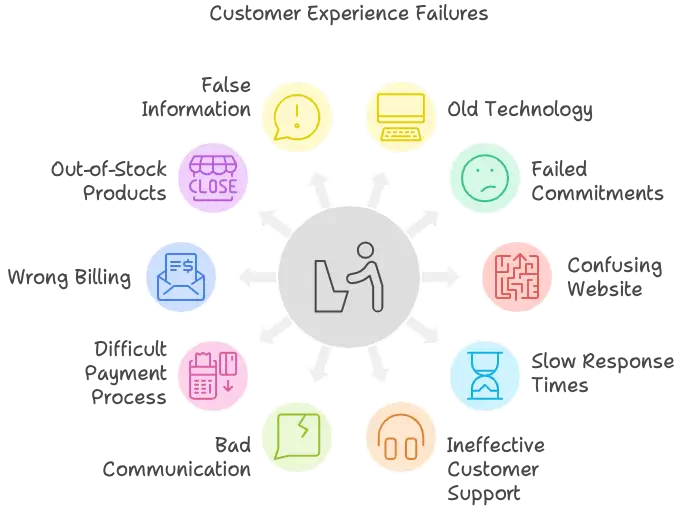
While many organizations work to improve their customer experience (CX), several key factors often lead to its failure. A lack of clear business objectives can create misalignment within teams, making it difficult to achieve desired outcomes. When CX programs aren’t tied to business goals, only a small percentage of leaders see success in exceeding customer expectations.
Balancing these elements is imperative for creating a positive customer experience and ensuring long-term satisfaction.
Old Technology
Old technology can considerably undermine customer experience efforts. When you rely on outdated systems, you might struggle to meet customer expectations. This can lead to frustration and decreased satisfaction.
Here are some issues you may face with old technology:
- Slow response times can hinder real-time interactions.
- Legacy systems often create data silos, preventing a complete view of the customer experience.
- Outdated software may limit your engagement options, reducing convenience.
- Inflexible technology makes it tough to adapt quickly to changing needs.
To improve customer experience, consider updating your systems. Investing in modern solutions can streamline processes and boost customer satisfaction.
Failed Commitments
Failed commitments in customer experience (CX) can severely undermine your organization’s efforts to build lasting relationships with customers.
When leadership engagement fades, enthusiasm for CX programs diminishes, leading to misalignment with business goals. This results in ineffective strategies that fail to meet customer expectations.
To avoid failed commitments, consider these actions:
- Confirm leadership stays actively involved in CX initiatives.
- Align CX efforts with measurable business objectives.
- Provide ongoing training for customer-facing employees.
- Regularly gather and act on customer feedback.
Confusing Website
Clarity is crucial regarding your website; a confusing layout can drive potential customers away. When visitors struggle to navigate, your customer experience suffers, leading to high bounce rates.
To improve, focus on creating a user-friendly interface. Here are some tips to take into account:
- Simplify navigation with clear menus and labels.
- Use consistent design elements to improve initial impressions.
- Prioritize significant information above the fold for easy access.
- Test your website with real users to identify confusing areas.
Slow Response Times
In relation to customer service, speed matters—66% of consumers say valuing their time is crucial for good service. Slow response times can frustrate customers and hurt your overall customer experience.
When you don’t respond quickly, you risk losing their trust and business. Here are a few key points to take into account:
- Customers expect an immediate response for urgent inquiries.
- Waiting over 10 minutes can lower customer satisfaction considerably.
- Quick replies increase your chances of meaningful conversations with potential customers.
- 82% of customers have stopped doing business due to poor service, often citing slow response times.
To improve customer satisfaction, prioritize fast communication.
Ineffective Customer Support
How can ineffective customer support hinder your business? It can seriously impact customer satisfaction and loyalty. When your team doesn’t meet customer expectations, it leads to frustration and churn.
Here are some common pitfalls:
- Inadequate training for customer support leads to inconsistent service quality.
- Long response times frustrate customers who expect immediate help.
- Limited support channels restricts access and can worsen dissatisfaction.
- Ignoring customer feedback means missing out on opportunities for improvement.
Bad Communication
Ineffective customer support often stems from poor communication, leading to misunderstandings that frustrate customers.
Bad communication can damage customer trust and create misalignment in your customer experience (CX programs).
To improve, focus on these key areas:
- Be clear about expectations: Confirm customers know what to expect from your service.
- Encourage customer feedback: Regularly ask for input and show that you value their opinions.
- Train your team: Equip staff with the skills to communicate effectively with customers.
- Align departments: Foster open communication between teams to provide consistent service.
Difficult Payment Process
While a seamless payment process might seem like a minor detail, it can make or break a customer’s experience. A difficult payment process leads to frustration and cart abandonment.
To enhance your checkout experience, consider these key factors:
- Offer diverse payment methods to cater to different preferences.
- Guarantee a clear and user-friendly payment interface.
- Maintain transparency about fees and processing times.
- Keep payment processes consistent across all channels.
Wrong Billing
Incorrect billing can severely damage customer loyalty and trust. When customers encounter billing errors, it can lead to frustration and confusion, affecting their overall customer experience.
Here are some key impacts of incorrect billing:
- 70% of customers may switch providers after a billing mistake.
- 38% reach out multiple times to resolve issues, increasing their frustration.
- Lack of transparency in billing erodes brand trust.
- Companies can see a 25% rise in customer churn if billing mistakes aren’t resolved quickly.
These operational inefficiencies can cost companies considerably.
To avoid incorrect billing, guarantee clear and accurate billing processes. Regular audits and clear communication can help build transparency, improve customer satisfaction, and reduce churn.
Prioritizing billing accuracy is crucial for retaining loyal customers.
Out-of-Stock Products
When customers can’t find the products they’re looking for, it can greatly impact their shopping experience. Out-of-stock products can lead to frustration, decreased customer satisfaction, and even loss of brand loyalty.
Here are some key points to reflect on:
- 70% of customers might abandon their purchase if an item is unavailable.
- 40% of consumers switch to competitors when they face product shortages.
- Businesses can lose up to 10% of sales due to unfulfilled demand.
- 23% of shoppers express dissatisfaction when products are out of stock.
To improve customer experience, effective inventory management is essential.
Accurate demand forecasting and supply chain optimization can help reduce out-of-stock occurrences, ultimately raising customer satisfaction and fostering brand loyalty.
False Information
Misleading information can severely undermine the customer experience, making it crucial for businesses to address this issue head-on.
When companies misinterpret data, they often implement misguided strategies that disconnect from actual customer needs. This can lead to a lack of trust and reduced customer satisfaction.
Here are some pitfalls to avoid:
- Relying solely on internal metrics, like NPS, for insights.
- Overemphasizing quantitative data while neglecting qualitative feedback.
- Failing to communicate clearly about CX initiatives across departments.
- Not linking CX metrics to real business outcomes.
Creating Customer Success Silos
Creating customer success silos can substantially hinder your organization’s ability to deliver a seamless experience.
When different departments operate independently, it creates confusion, leading to inconsistent messaging and service delivery. This fragmentation can harm your customer experience.
Here’s how silos impact your organization:
- They prevent effective sharing of customer insights.
- They block collaboration across teams.
- They lead to fragmented customer experiences.
- They make it difficult to align CX strategies with business goals.
To overcome these challenges, fostering a culture of collaboration is crucial.
Encourage departments to work together, share insights, and focus on the customer. By breaking down silos, you not only improve customer engagement but also elevate overall satisfaction, ultimately leading to better loyalty.
Over-Engaging Your Customers
Over-engaging your customers can backfire, leading to fatigue and frustration. When you overwhelm them, it harms the entire customer experience.
Here’s how over-engaging customers can hurt your brand:
- 67% of consumers feel overwhelmed by excessive marketing communications.
- Frequent interactions can dilute touchpoints, lowering engagement rates.
- 50% of customers prefer brands that respect their time and space.
- 45% of consumers unsubscribe from emails due to too many messages.
To avoid a negative customer experience, focus on balanced engagement. Respect your customers’ time, and give them space when needed.
How to Identify Customer Experience Issues
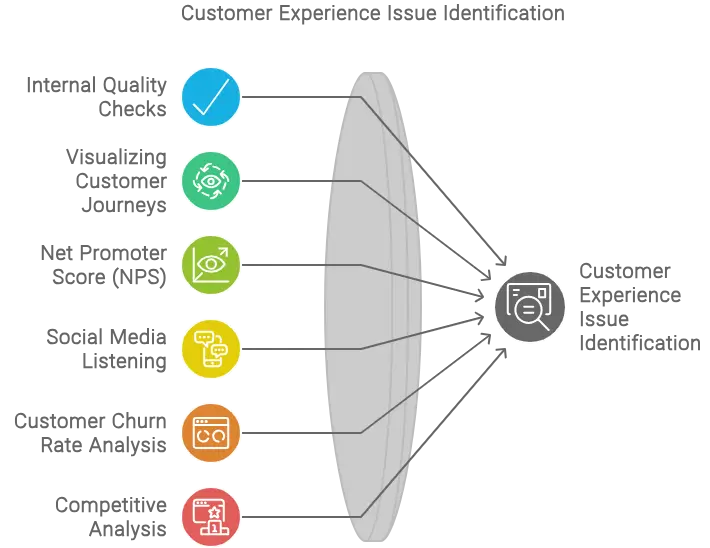
To identify customer experience issues, start with internal quality checks and visualize customer pathways.
Use tools like Net Promoter Score (NPS) and listen to social media for valuable feedback.
Furthermore, analyze your customer churn rate to uncover patterns that can help you improve the comprehensive experience.
Internal Quality Checks
While many organizations prioritize customer feedback, internal quality checks are just as crucial for identifying customer experience issues.
Regular internal audits can uncover gaps in service delivery, ensuring your team meets customer expectations effectively. Here are some key strategies to implement:
- Conduct regular customer feedback surveys to identify pain points.
- Establish clear metrics, like Customer Satisfaction Score (CSAT) and Net Promoter Score (NPS).
- Utilize data analytics to monitor service interactions and spot patterns.
- Foster a culture of continuous improvement by acting on feedback.
Visualizing Customer Journeys
Understanding customer experience issues starts with visualizing customer paths. By mapping out each touchpoint, you can identify customer pain points and areas needing improvement. This process not only improves satisfaction but also aligns your team on customer experience goals.
Here are some effective steps:
- Use journey mapping techniques to visualize customer experiences.
- Incorporate customer feedback into your visualizations for relevance.
- Regularly review and update experience maps to adapt to changes.
- Collaborate across departments for a unified view.
These strategies foster continuous improvement, ensuring that your organization responds to evolving customer needs. By embracing this approach, you’ll create a more satisfying experience for your customers and strengthen your brand’s reputation.
Net Promoter Score (NPS)
The Net Promoter Score (NPS) is a powerful tool that helps businesses gauge customer loyalty and satisfaction by categorizing respondents into promoters, passives, and detractors.
Understanding your NPS can pinpoint areas needing improvement in your customer experience. Here’s how to utilize NPS effectively:
- Analyze feedback from detractors to identify specific pain points.
- Track NPS over time to spot trends in customer satisfaction.
- Use high NPS scores to increase customer loyalty and retention.
- Adapt your strategies based on customer feedback to improve service.
While NPS is valuable, remember to interpret results cautiously, as external factors might influence scores.
Regularly engaging with your customers can lead to actionable insights and a better comprehensive customer experience.
Social Media Listening
NPS provides valuable insights into customer loyalty, but it’s not the only way to gauge satisfaction.
Social media listening is crucial for identifying customer experience issues. It allows you to monitor sentiment in real-time and uncover potential problems.
Here are some benefits of social media listening:
- Reveals recurring themes and pain points
- Supports proactive problem-solving
- Identifies key influencers and trends
- Improves engagement and builds trust
Conduct Customer Churn Rate Analysis
Analyzing customer churn rates is essential for uncovering underlying issues in the customer experience. By understanding your customer churn rate, you can identify potential problems and areas for improvement.
Here are some steps to guide you:
- Track the percentage of customers lost over time.
- Monitor customer behaviors, like purchase frequency and engagement.
- Segment churn data by demographics or behavior for targeted insights.
- Implement regular feedback loops and surveys to gather customer opinions.
These strategies will help you develop effective retention strategies and elevate your CX programs.
By addressing the factors that lead to churn, you can improve customer experience and build lasting relationships.
Competitive Analysis
In relation to identifying customer experience issues, conducting a competitive analysis can be a game-changer.
By comparing your business to competitors, you can pinpoint gaps in your customer experience strategy. Here are some effective steps to take into account:
- Conduct regular customer surveys to gather valuable customer feedback.
- Analyze customer churn rates to understand why customers leave and identify experience issues.
- Monitor social media channels and online reviews for real-time customer sentiment insights.
- Utilize competitive benchmarking against industry leaders to adopt best practices in experience management.
User Experience Testing
User experience testing plays a crucial role in identifying customer experience issues that can hinder satisfaction and loyalty. By gathering qualitative data, you can uncover pain points in the customer process and make necessary improvements.
Here are some effective techniques to evaluate:
- A/B testing to compare different designs
- Usability testing to observe real user interactions
- User surveys to gather feedback directly
- Heatmaps to analyze user behavior on your site
Regularly conducting user experience testing can lead to a 20-30% increase in customer satisfaction scores. This process not only reveals areas for design improvements but also fosters a customer-centric culture.
FAQ
Why does customer experience fail?
Customer experience often fails due to a lack of focus on the customer, poor communication, and ineffective processes. Businesses need to prioritize the customer, improve internal coordination, and streamline operations to deliver a positive experience.
What is bad customer experience?
Bad customer experience refers to negative interactions or issues that customers have when dealing with a business or product. This can include things like long wait times, unhelpful or rude customer service, confusing or difficult-to-use products or services, and unresolved problems or complaints.
Why customer service is failing?
Customer service is failing due to a lack of empathy, poor training, and inefficient processes. Businesses need to invest in improving their customer service to remain competitive.
How to fix a poor customer experience?
Improve website navigation, ensure fast page load times, provide clear contact information, offer responsive customer support, collect customer feedback, and address issues promptly.
